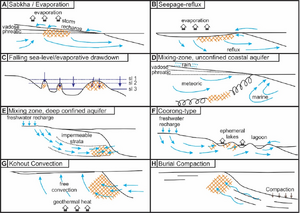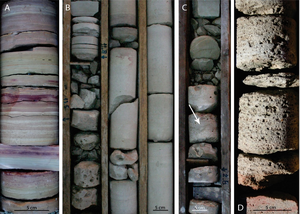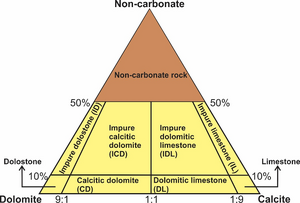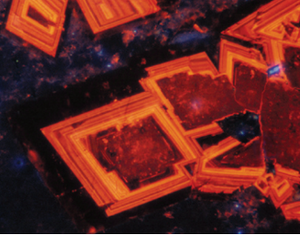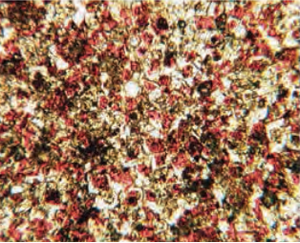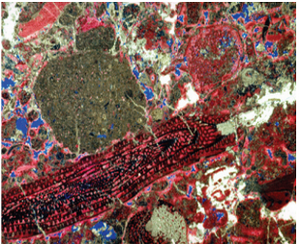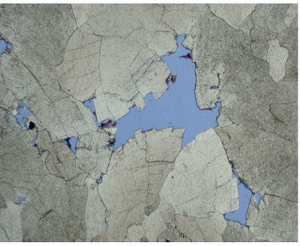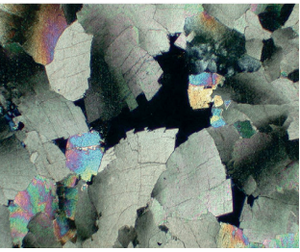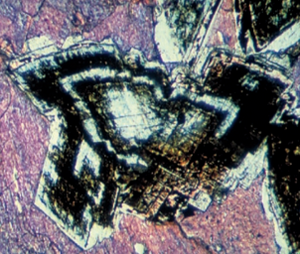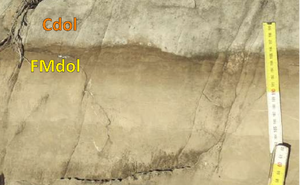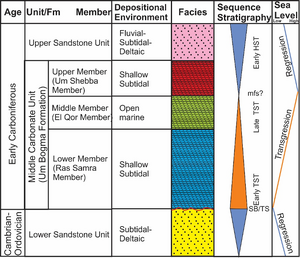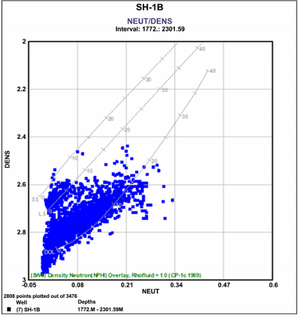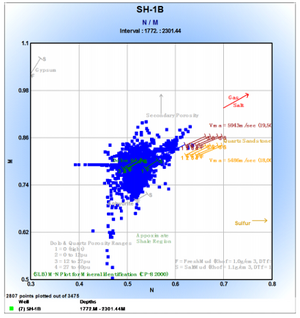Dolomite and dolomitization: Implications for reservoir characterization
| Wiki Write-Off Entry | |
|---|---|

| |
| Author | Muhammad Awais |
| Affiliation | University of Naples, University of Swabi |
| Competition | 2021 Middle East Wiki Write Off |
Dolomite is a rhombohedral carbonate mineral having chemical formula CaMg(CO3)2 (Tucker and Wright, 1990). The process of formation of dolomite is called dolomitization (Tucker and Wright, 1990). Dolomite is dominantly a marine mineral / rock but it can also be formed in continental environments e.g., karst and lakes (Baldermann et al., 2020). There can be primary and secondary dolomites but the former one is very rare and most of the dolomites are secondary in origin (Tucker and Wright, 1990). According to Flügel (2010), there are three genetic groups of dolostones i.e. syn-genetic, diagenetic and epi-genetic dolostones.
The origin of dolomite is still debateable and different models have been proposed by different researchers such as sabkha/evaporation, seepage-reflux, mixed marine-meteoric water, Coorong type, Kohout convection, burial compaction and falling sea-level/evaporative drawdown (Fig. 1; Tucker and Wright, 1990). Usually, dolomites not associated with evaporites are considered to be formed in mixed marine-meteoric zone while dolomites associated with evaporites are formed in seepage-reflux and evaporative drawdown model(s) (Morrow, 1982a, b; Awais et al., 2020a). Some other models of dolomitization includes organogenic/microbial, hydrothermal, geothermal, hydrofrigid, fault-controlled and fracture-related dolomitization (Machel and Lonnee, 2002; Scholle and Ulmer-Scholle, 2003; Shah et al., 2016; Rustichelli et al., 2017). There is still confusion in all dolomitization models about the source of Mg2+ and the mechanism through which dolomitizing fluids are pumped through carbonate sediments (Tucker and Wright, 1990). On a local scale, dolomitized sediments can be the source of magnesium i.e. Mg2+ originally present in or adsorbed by Mg-calcites, biogenic silica, clay minerals, chlorophyll, organic matter and or pre-existing detrital dolomites (Lyons et al., 1984; Baker and Burns, 1985).
Dolomitization can takes place at different phases of diagenesis, for example, early diagenesis to deep burial (Fig. 2). Similarly, it can occur due to fluids of variety of compositions such as sea water, mixed marine-meteoric water, hypersaline and burial brines (Fig. 2; Adams and MacKenzie, 1998).
Tools and Techniques for studying dolomite and dolomitization[edit]
The fundamental material for studying dolomite is outcrop, cores, polished-slabs / peels and thin sections (Figs. 3 and 4). The tools and techniques used to study dolomite and dolomitization includes visual and hand lens inspection of outcrops, cores, polished slabs and peels, petrographic microscopy using thin section, scanning electron microscopy (SEM) using rock slab and thin section, backscattered electron imaging (BSEM), electron microprobe (EMP), Cathodoluminescence (CL), Energy Dispersive X-ray Spectroscopy (EDS), X-Ray Diffraction (XRD) analysis, X-ray Fluorescence, Transmission Electron Microscopy (TEM), QEMSCAN (quantitative evaluation of minerals by scanning electron microscopy) and geochemical analysis (alizarin red staining; major and trace elements geochemistry; isotopes of carbon, magnesium, oxygen and strontium). Dolomite’s fluid inclusion analysis is also conducted to determine microthermometry and salinity. The sub-surface dolomite or dolostone can be studied using conventional petrophysical logs. Now-a-days, research focused on dolomite precipitation experimentally in the laboratory is also going on. Furthermore, testing of dolomitization process using numerical simulations (i.e. reactive transport modelling) is also one of the latest research trend for carbonate sedimentologists.
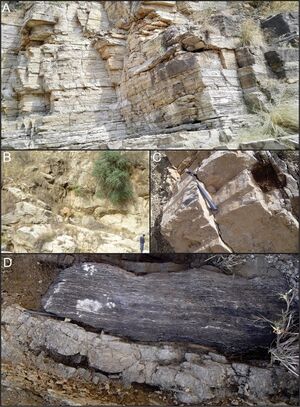
Composition, Petrography and Texture / Fabric of Dolomite / Dolostones[edit]
Compositionally, dolomite can be pure dolomite, calcian dolomite / limy dolomite, slightly calcian dolomite, argillaceous dolomite and ferroan dolomite (<10 mol percent FeCO3) (Frisia, 1994; Machel, 2004). The dolomite containing rock(s) can have different names based on quantity of dolomite such as dolostone, impure dolostone, calcitic dolomite, dolomitic limestone, impure dolomitic limestone and impure calcitic dolomite (Table 1; Fig. 5; Leighton and Pendexter, 1962).
Table 1: Carbonate rock types having varying percentages of dolomite and calcite (after Leighton and Pendexter, 1962). Carbonate rock type Dolomite percentage (%) Calcite percentage (%) Dolomite >90% <10% Calcitic dolomite 50-90% 10-50% Dolomitic limestone 10-50% 50-90% Limestone <10% >90%
Petrographically, dolomite is usually identified due to its rhombohedron crystal habit / rhombic crystal shape (Fig. 6a). The dolomite is usually zoned and untwinned (Fig. 6a; Scholle and Ulmer-Scholle, 2003). In dolomitic limestones and calcitized dolostones, dolomite is identified via Alizarin Red-staining (ARS) technique i.e. dolomite remains unstained and calcite becomes red-colored (stained) (Figs. 6b and 6c).
Different terms are used to define dolomite crystal sizes such as dolomicrostone (<4 µm), dolomicrosparstone (4–10 µm) and dolosparstone (>10 µm) (Wright, 1992). Similarly, Lucia (1995) classification of dolomite crystal size includes fine to medium crystalline dolomite (<20 µm to 100µm) and coarse crystalline (>100 µm). Other textural terms based on crystal size includes cryptomere (very fine crystalline), dolomicrite / micrite dolomite / microlite (crystal size <1 µm), dolosparite, dololutite (clay or mud size, <1/16 mm), dolosiltite (silt size, 1/16-1/256 mm) , dolarenite (sand size, 1/16-2 mm), dolorudite (coarser than sand, >2 mm) and macrocrystalline dolomites (Calver and Baillie, 1990; Bojiang et al., 2012; Barlow et al., 2016; Yang et al., 2017).
Sibley and Gregg (1987) defined the texture of dolomite, for example, planar and non-planar crystals based on crystal shapes and hence there are different mosaics of dolomite (Fig. 7). The planar crystals can be euhedral (planar-e) and subhedral (planar-s) and results in the formation of idiotopic and hypidiotopic mosaics respectively. The non-planar dolomite crystals are anhedral and making xenotopic mosaic (Fig. 7; Sibley and Gregg, 1987). In planar dolomites, the crystal boundaries between dolomite crystals are straight and planar. On the contrary, non-planar dolomites have curved, irregular or lobate crystal boundaries between dolomite crystals (Machel, 2004).
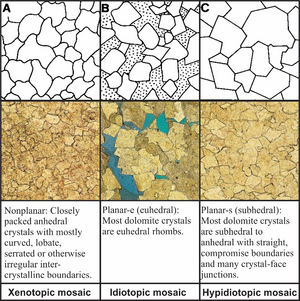
Planar dolomites have straight extinction while non-planar dolomites have segment / sweeping extinction (Machel, 2004). Sometimes, the planar fabric containing euhedral dolomite crystals is easily seen in rocks having some intercrystalline pore spaces (see idiotopic mosaic in Fig. 7; Adams and MacKenzie, 1998). Sometimes, planar dolomites are usually equicrystalline imparting sugary texture to the rock and called as Sucrosic dolomites (Machel, 2004). The sugary texture is identifiable in hand specimen and using hand-lens as light reflects-off dolomite crystals faces (Machel, 2004).
There is another variety of high temperature (60 - 150°C) Ca- and Fe-rich burial dolomite called as Baroque or saddle dolomite (Fig. 8). Such dolomites are petrographically recognized by curved crystal faces, invariably sparry, usually milky white, curved cleavages, having undulose extinction, pearly lustre and cloudy appearance due to abundant fluid inclusions (Fig. 8; Adams and Mackenzie, 1998; Scholle and Ulmer-Scholle, 2003). These dolomites are mostly occuring as cements and fractures-fill (Adams and Mackenzie, 1998).
The texture of dolomite under the petrographic microscope gives clue(s) about origin of dolomites but the interpretation of main dolomitization model(s) is based on detailed geological and geochemical data (Flügel, 2010). The replacement fabrics of dolomite are categorized as unimodal and polymodal based on crystal size distribution (Sibley and Gregg, 1987). Unimodal and polymodal dolomites are also called as equicrystalline and inequicrystalline dolomites respectively (Adams and Mackenzie, 1998). Moreover, dolomite or dolomitization is classified as mimic or mimetic (fabric-preserving) and non-mimic or non-mimetic (fabric destroying) dolomite (Fig. 9; Sibley and Gregg, 1987; Adams and Mackenzie, 1998). Most non-mimetic dolomites contains ‘ghosts’ which are usually non-carbonate sediments and shows outline or internal pattern of precursor allochems or cements (Machel, 2004). The partial or selective dolomitization can be fabric-selective (replacing particular constituents of limestone) and non-fabric selective (replacing different or all components of the limestone in a chaotic manner) (Fig. 9; Adams and Mackenzie, 1998). Allochems like echinoderms and corraline algae are commonly mimetically replaced while brachiopods cannot be mimetically replaced (Sibley, 1982). Most replacement dolomites have cloudy cores and clear peripheries (Fig. 9I; Keyser et al., 2002).
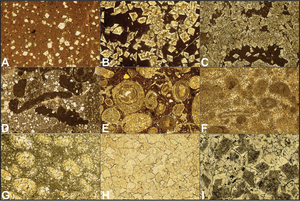
Dolomite / dolostone occurrence in nature[edit]
Dolomite / dolostone is found in nature in the form of thin-, medium-, thick-, very thick-bedded and massive units (Figs. 3 and 4). Laminated dolostone also occurs in nature called as dololaminite and as surficial layer called as dolomite crust. The variations in crystal size of dolomite can generate varied colored layering in carbonates, for example, brownish colored layering (fine-medium crystalline dolomites) and light colored layering (coarse crystalline dolomite), as reported by Vinci et al. (2017) in Cretaceous carbonates of Southern Apennines (southern Italy) (Fig. 10a). Nodular dolomite patches are also noticed in rock record, for example, in nodular dolomustone in Miocene Asmari Formation of Qaleh Nar Oil Field, Iran (Fig. 10b; Esrafili-Dizaji and Rahimpour-Bonab, 2019). Spheroidal and complex polyhedral of dolomites are also reported but the the former one existed in association with submarine hydrothermal vents, hydrocarbon seeps and possibly bacteria (Naiman et al., 1983; Gunatilaka, 1989; Gregg et al., 1992; Nielsen et al., 1997).
In the rock record, most of the dolomites have replacement (secondary) origin especially in carbonates. They are formed by replacement of pre-existing aragonite, high-Mg calcite and low-Mg calcite (but very less) (Scholle and Ulmer-Scholle, 2003). There are many replacement fabrics of dolomite, for example, micro-crystalline replacements to limpid, zoned, selective / partial and pervasive / complete replacements and cements (Fig. 9). The zoning in dolomite can be compositional, due to presence of inclusions and precipitation of metastable minerals etc (Figs. 6a and 9I; Adams and Mackenzie, 1998; Scholle and Ulmer-Scholle, 2003). In most cases, the inclusions can be calcite, fluid inclusions, micropores and or inclusions of non-carbonate sediments like clay (Adams and Mackenzie, 1998; Kordi et al., 2017).
The dolomite cements, generally found in carbonates and clastics, are precipitated directly from pore fluids during diagenesis (Tucker and Wright, 1990; Chen et al., 2019). The dolomite cement can also be primary dolomite cement or the replacement of calcite cement (Adams and Mackenzie, 1998). Dolomite cement rims on detrital grains are noticed in Permian Park City Formation of Utah, USA (Fig. 11A; Scholle and Ulmer-Scholle, 2003). Dolomite overgrowths are noticed in Lower Cretaceous Shuaiba Formation in Offshore Qatar (Fig. 11B; Scholle and Ulmer-Scholle, 2003). Dolomite fibrous cements are reported in Ediacaran Dengying Formation of China (Fig. 11C; Hu et al., 2020). The dolomite can also occur as aphanocrystalline crystals, for example, as noticed in Upper Permian Tansill Formation of New Mexico (Fig. 11D; Scholle and Ulmer-Scholle, 2003). Dolomite can occur as syntaxial overgrowth (i.e. dolomite overgrowth) around dolomite crystals (Figs. 11E and 11F; Scholle and Ulmer-Scholle, 2003). It can also occur as discrete crystals filling intergranular pores and fractures and as lining in molds (Fig. 11G; Scholle and Ulmer-Scholle, 2003; Kordi et al., 2017; Awais et al., 2019). Dolomite-cementation can takes place in burrows, for example, Middle to Upper Ordovician Red River Formation, North Dakota, USA (Fig. 11H; Scholle and Ulmer-Scholle, 2003). There can also be dolomitization front in carbonates when one part is completely dolomitized and the adjacent part contains scarce dolomites (Fig. 11I; Scholle and Ulmer-Scholle, 2003).
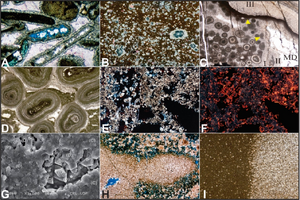
Dolomitization and Sequence Stratigraphy[edit]
Dolomitization can be controlled by sequence stratigraphic parameters i.e. rate of productivity and accumulation of carbonates; hydrologic factors and circulation pattern(s), which takes place in response to transgression and regression; pore-waters chemical composition and dynamics of marine, meteoric and mixed marine-meteoric pore-water areas and residence-time of carbonates in specific geochemical conditions which is influenced by duration of cycles of relative sea-level changes (Moss and Tucker, 1996; Morad et al., 2012). Kordi et al. (2017) related dolomitization with transgression (sequence stratigraphy) in Carboniferous Um Bogma Formation (Sinai, Egypt) (Fig. 12). These Carboniferous dolostones are formed by two marine transgression episodes (i.e. transgressive systems tract-TST, and initial time of highstand systems tract-HST) (Fig. 12; Kordi et al., 2017). In addition, similar interpretation is also made by Peyravi et al. (2016) i.e. the TST and lower part of HST are mostly containing dolomite in Lower Triassic Kangan Formation of Persian Gulf. Manche and Kaczmarek (2019) interpreted, in Cretaceous carbonates of Upper Glen Rose Formation of Central Texas (USA), that dolomite characteristics (i.e. quantity, crystal size, stoichiometry and Oxygen-18 isotope, δ18O) varies with transgression and regression. The regressive facies contains increasing dolomite quantity, dolomite stoichiomtery and δ18O (VPDB), and reducing crystal size of dolomites. On the contrary, the transgressive facies contains reducing dolomite quantity, dolomite stoichiometry and δ18O (VPDB), and increasing crystal size of dolomite (Manche and Kaczmarek, 2019).
Dolomitization and Porosity Evolution[edit]
During dolomitization, porosity may be produced, maintained and vanished (Fig. 13; Machel, 2004). The replacement of aragonite and or high-Mg calcite by dolomite leads to development of dolomoldic porosity (Fig. 13A; Scholle and Ulmer-Scholle, 2003). The replacement of limestone by dolostone increases the porosity by 13% (Fig. 13B; Machel, 2004). Dolomitization generally increases porosity, for example, in Upper Jurassic to Lower Cretaceous carbonates of southern Italy, it has increased matrix porosity up to 7 % (Rustichelli et al., 2017). Sometimes, selective dissolution of dolomites takes place during telogenetic diagenesis and hence porosity is developed in carbonates. Furthermore, seldom selective zones are also dissolved in dolostones and sometimes whole zones are completely dissolved and leached-out, for example, as noticed in Mississipian Terrero Formation, New Mexico (Scholle and Ulmer-Scholle, 2003). The dolostone texture and reservoir properties are greatly variable i.e. in matrix-selective dolomitization, the porosity is dominantly remnant primary porosity having poor interconnection. In non-matrix-selective dolomitization or rocks with coarse crystalline matrix (sucrosic dolomites) has intercrystalline porosity and excellent permeability (Machel, 2004).
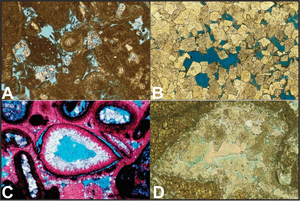
Murray (1968) reported a relationship between dolomite quantity and porosity. He noticed porosity reduced with raising dolomite quantity when the total dolomite percentage is < 50 % in a rock while porosity raises with increasing dolomite content when dolomite percentage in a rock is > 50% (Fig. 14a; Murray, 1968). In dolomite reservoirs of Nanpu Sag (China), dolomites have reduced the porosity when they are scattered in the matrix because due to compaction they occupied pore spaces. But dolomites have also preserved and increased the porosity when coarse crystalline dolomites are formed and which resisted the influence of compaction (Bojiang et al., 2012). Therefore, Bojiang et al. (2012) interpretation also validates Murray (1968) observation. Bojiang et al. (2012) envisaged that fluid movement is efficient in coarse crystalline dolomites and less efficient in fine-crystalline and micrite dolomites. Therefore, rocks having coarse crystalline dolomites are good reservoirs as compared to fine-crystalline and micrite-dolomites (Bojiang et al., 2012).
Dolomite cementation (overdolomitization) in the form of syntaxial overgrowth, discrete and clustered crystals occupying intergranular pores and fractures reduces porosity and permeability (Fig. 14b; Lucia, 2004; Martín-Martín et al., 2015; Kordi et al., 2017). In Middle Eocene Avon Park Formation (South Florida, USA), dolomitization (cementation) reduced the total porosity to 9 % (Scholle and Ulmer-Scholle, 2003). In Carboniferous Um Bogma Formation (Egypt), dolomite occurence as cement in intercrystalline / intergranular pores has reduced reservoir quality (Kordi et al., 2017). However, it is not necessary that overdolomitization reduces porosity all the time, for example, in Permian–Triassic Kangan and Dalan formations of Persian Gulf, overdolomitizaton has no significant influence on the reservoir quality (Tavakoli and Jamalian, 2019). Hence, dolomite presence can enhance, impede and having no effect on geofluids (especially hydrocarbons) storage and transmitting capacity in carbonates.
Petrophysical response of dolomites[edit]
The dolomite can also be identified indirectly in the subsurface using petrophysical logs (gamma ray, density, sonic etc; Fig. 15). The Gamma ray (GR) log response of dolostone / dolomite-rich carbonates can be lower than the shale baseline (Schlumberger, 1989; Rider, 1996). However, it can be high rarely might be due to radioactive minerals (uranium) in veins. The Photoelectric factor (PEF) of dolomite is 3.14 barns / electron (Schlumberger, 1989). The bulk density of dolomite is 2.87 g/cm3 (Schlumberger, 1989). The sonic matrix time for dolomite is 44 us/ft (Rider, 1996).
Usually GR log is used to demarcate shale and non-shale (limestone, dolostone) lithology. However, within a carbonate succession, limestone and dolostone are differentiated using a combo of neutron and density logs. For limestone, both logs will overlap while for dolostones they will be at a distance (Fig. 15; Lucia, 2007). The interpretation of Lucia (2007) is noticed in Paleocene-Eocene Khurmala Formation and Jurassic Butmah Formation of Iraq respectively (Rashid et al., 2020; Zangana et al., 2020). Similarly, neutron-density cross-plot is also used for lithology identification (Fig. 16; Rider, 1996; Zangana et al., 2020). In addition, M-N cross-plot is also usually used to determine lithology of geological formations having heterogenous lithologies (Rider, 1996; Zangana et al., 2020).
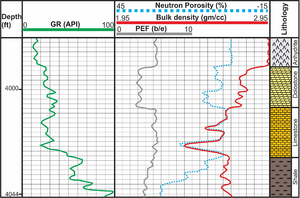
Examples of hydrocarbon producing Dolostone reservoirs[edit]
Cambrian Jutana Formation (dominated by dolostone) is a proven producing hydrocarbon reservoir rock in Potwar Plateau, Pakistan (Khan et al., 1986). Middle - Upper Ordovician Red River Formation (North Dakota, USA) is producing from intercrystalline porosity (Scholle and Ulmer-Scholle, 2003). The Lower Triassic Kangan Formation is the major carbonate (dolomite-rich) reservoir of natural gas in southwest Iran and Persian Gulf (Peyravi et al., 2016). Upper Jurassic Arab D Carbonate (Dukhan Field, Qatar) is producing from biomoldic and oomoldic porosities (Scholle and Ulmer-Scholle, 2003). Lower Cretaceous Shuaiba Formation (Offshore Qatar) is producing from patchy and intercrystalline porosities (Scholle and Ulmer-Scholle, 2003). Oligocene to Lower Miocene Asmari Formation (containing dolomite) is a giant hydrocarbon producing reservoir in Iran (Lackpour et al., 2008).
References[edit]
Adams, A.E., MacKenzie, W.S., 1998. A colour atlas of Carbonate sediments and rocks under the microscope. Manson Publishing.
Awais, M., Hanif, M., Ishaq, M., Jan, I.U., 2020a. An integrated approach to evaluate dolomite in the Eocene Chorgali Formation, Khair-e-Murat Range, Pakistan: Implications for Reservoir Geology. Journal of Himalayan Earth Sciences, 53(1), 12-23.
Awais, M., Hanif, M., Jan, I.U., Ishaq, M., Khan M.Y., 2020b. Eocene carbonate microfacies distribution of the Chorgali Formation, Gali Jagir, Khair-e-Murat Range, Potwar Plateau-Pakistan: Approach of reservoir potential using outcrop analogue. Arabian Journal of Geosciences, 13(4), 1-18.
Awais, M., Hanif, M., Khan, M.Y., Jan, I.U., Ishaq, M., 2019. Relating petrophysical parameters to petrographic interpretations in carbonates of the Chorgali Formation, Potwar Plateau, Pakistan. Carbonates and Evaporites, 34(3), 581-595.
Baker, P.A., Burns, S.J., 1985. Occurrence and formation of dolomite in organic-rich continental margin sediments. Bulletin of American Association of Petroleum Geologists, 69, 1917-1930.
Barlow, E., Van Kranendonk, M.J., Yamaguchi, K.E., Ikehara, M., Lepland, A., 2016. Lithostratigraphic analysis of a new stromatolite–thrombolite reef from across the rise of atmospheric oxygen in the Paleoproterozoic Turee Creek Group, Western Australia. Geobiology, 14, 317-343.
Bojiang, F., Xiaoming, Z., Jian, Z., Xiongqi, P., Chenglin, L., 2012. Dolomitization and the causes of dolomitization dolomite reservoir. Chinese Journal of Geochemistry, 31, 147-154.
Baldermann, A., Mittermayr, F., Bernasconi, S.M., Dietzel, M., Grengg, C., Hippler, D., Kluge, T., Leis, A., Lin, K., Wang, X., Zünterl, A., Boch, R., 2020. Fracture dolomite as an archive of continental palaeo-environmental conditions. Communications Earth and Environment, 1, 35.
Calver, C.R., Baillie, P.W., 1990. Early diagenetic concretions associated with intrastratal shrinkage cracks in an upper Proterozoic dolomite, Tasmania, Australia. Journal of Sedimentary Petrology, 60(2), 293-305.
Chen, B., Wang, F., Shi, J., Chen, F., Shi, H., 2019. Origin and Sources of Minerals and Their Impact on the Hydrocarbon Reservoir Quality of the Paleogene Lulehe Formation in the Eboliang Area, Northern Qaidam Basin, China. Minerals, 9, 436.
Esrafili-Dizaji, B., Rahimpour-Bonab, H., 2019. Carbonate Reservoir Rocks at Giant Oil and Gas Fields in SW Iran and the adjacent Offshore: A review of stratigraphic occurrence and poro-perm characteristics. Journal of Petroleum Geology, 42(4), 343-370.
Flügel, E., 2010. Microfacies of Carbonate Rocks-Analysis, interpretation and application, 2nd edition. Springer-Verlag, Berlin, Heidelberg.
Frisia, S., 1994. Mechanisms of complete dolomitization in a carbonate shelf: comparison between the Norian Dolomia Principale (Italy) and the Holocene of Abu Dhabi Sabkha. International Association of Sedimentologists Special Publications, 21, 55-74.
Gregg, J.M., Scott, H., Mazzullo, S.J., 1992. Early diagenetic recrystallization of Holocene (<300 years old) peritidal dolomites, Ambergis Cay, Belize. Sedimentology, 39, 143-160.
Gunatilaka, A., 1989. Spheroidal dolomites – origin by hydrocarbon seepage? Sedimentology, 36, 701 – 710.
Hu, Y., Cai, C., Liu, D., Pederson, C.L., Jiang, L., Shen, A., Immenhauser, A., 2020. Formation, diagenesis and palaeoenvironmental significance of upper Ediacaran fibrous dolomite cements. Sedimentology, 67, 1161-1187.
Janson, X., Lucia, F.J., Jennings, J.W., Bellian, J.A., AbuBshait, A.A., Al-Dukhayyil, R.K. Mueller, H.W., Cantrell, D., 2014. Chapter 12 ‘Outcrop-based 3D geological and reservoir model of the uppermost Khuff Formation in central Saudi Arabia’. In: Permo-Triassic sequence of the Arabian Plate, Proppelreiter, M.C. (Ed.), EAGE Publications. Pp. 269-302.
Keyser, T.K., James, N.P., Bone, Y., 2002. Shallow burial dolomitization and dedolomitization of Cenozoic cool-water limestones, southern Australia: geochemistry and origin. Journal of Sedimentary Research, 72, 146-157.
Khan, A.M., Ahmad, R., Raza, H.A., Kemal, A., 1986. Geology of petroleum in Kohat-Potwar depression, Pakistan. Bulletin of American Association of Petroleum Geologists, 70, 396–414.
Kleesment, A., Urtson, K., Kiipli, T., Martma, T., Põldvere, A., Kallaste, T., Shogenova, A., Shogenov, K., 2013. Temporal evolution, petrography and composition of dolostones in the Upper Devonian Plavinas Regional Stage, southern Estonia and northern Latvia. Estonian Journal of Earth Sciences, 62(3), 139-159.
Kordi, M., Morad, S., Turner, B., Salem, A.M.K., 2017. Sequence stratigraphic controls on formation of dolomite: Insights from the Carboniferous Um Bogma Formation, Sinai-Egypt. Journal of Petroleum Science and Engineering, 149, 531-539.
Lackpour, M., Chilingar, G.V., Kalantari, A., 2008. Asmari Limestone of Iran: A giant of oil and gas production. Energy Sources, Part A, 30, 1523-1533.
Land, L.S., 1985. The origin of massive dolomite. Journal of Geological Education, 33, 112-125.
Leighton, M.W., Pendexter, C., 1962. Carbonate rock types. In: Classification of carbonate rocks, Ham, W.E. (Ed.). American Association of Petroleum Geologists Memoir 1, 33-61.
Lucia, J.F., 1995. Rock-fabric/petrophysical classification of carbonate pore space for reservoir characterization. Bulletin of American Association of Petroleum Geologists, 79, 1275–1300.
Lucia, F.J., 2004. Origin and petrophysics of dolostone pore space. In: The Geometry and petrogenesis of dolomite hydrocarbon reservoirs. Braithwaite, C. J. R., Rizzi, G., Darke, G. (eds.). The Geological Society of London, Special Publications, 235, 141-155.
Lucia, F.J., 2007. Carbonate Reservoir Characterization, An integrated approach. Second Edition. Springer, 82-84.
Lyons, W.B., Hines, M.E., Gaudette, H.E., 1984. Major and minor element pore water geochemistry of modern marine sabkhas: the influence of cyanobacterial mats. In Cohen, Y., Castenholz, R. W., and Halvorson, H. O., (eds.), Microbial mats, New York: A. R. Liss, pp. 411-423.
Machel, H.G., Lonnee, J., 2002. Hydrothermal dolomite—a product of poor definition and imagination. Sedimentary Geology 152(3-4), 163-171.
Machel, H.G., 2004. Concepts and models of dolomitization: a critical reappraisal. Geological Society, London, Special Publications, 235, 7-63.
Manche, C.J., Kaczmarek, S.E., 2019. Evaluating reflux dolomitization using a novel high-resolution record of dolomite stoichiometry: A case study from the Cretaceous of central Texas, USA. Geology, 47(6), 586-590.
Martín-Martín, J.D., Travé, A., Gomez-Rivas, E., Salas, R., Sizun, J.P., Vergés, J., Corbellae, M., Stafford, S.L., Alfonso, P., 2015. Fault-controlled and stratabound dolostones in the Late Aptian- earliest Albian Benassal Formation (Maestrat Basin, E Spain): Petrology and geochemistry constrains. Marine and Petroleum Geology, 65, 83-102.
Morad, S., Ketzer, J.M., De Ros, L.F., 2012. Linking Diagenesis to Sequence Stratigraphy: An Integrated Tool for Understanding and Predicting Reservoir Quality Distribution (eds.), Linking Diagenesis to Sequence Stratigraphy. International Association of Sedimentologists, Special Publication, 45, pp. 1–36.
Morrow, D.W., 1982a. Diagenesis I. Dolomite – part I. The chemistry of dolomitization and dolomite precipitation. Geoscience Canada, 9, 5-13.
Morrow, D.W., 1982b. Diagenesis II. Dolomite – part II. Dolomitization models and ancient dolostones. Geoscience Canada, 9, 95-107.
Moss, S.J., Tucker, M.E., 1996. Dolomitization associated with transgressive surfaces–a mid Cretaceous example. Sedimentary Geology, 107, 11–20.
Murray, R.C., 1960. Origin of porosity in carbonate rocks. Journal of Sedimentary Petrology, 30, 59-84.
Murray, G.H., 1968. Quantitative fracture study, Sanish pool, Mckenzie County, North Dakota. Bulletin of American Association of Petroleum Geologists, 52, 57−65.
Naiman, E.R., Bein, A., Folk, R.L., 1983. Complex polyhedral crystals of limpid dolomite associated with halite., Permian Upper Clear Fork and Glorieta formations, Texas. Journal of Sedimentary Petrology, 53, 549-555.
Nielsen, P., Swennen, R., Dickson, J.A.D., Fallick, A.E., Keppens, E., 1997. Spheroidal dolomites in a Visean karst system-bacterial induced origin. Sedimentology, 44, 177-195.
Peyravi, M., Rahimpour-Bonab, H., Nader, F.H., Kamali, M.R., 2016. Chemo-stratigraphy as a tool for sequence stratigraphy of the Early Triassic Kangan Formation, North of the Persian Gulf. Carbonates and Evaporites, 31, 163-178.
Rashid, F., Hussein, D.O., Zangana, H.A., 2020. Petrophysical Investigation of the Khurmala Formation in Taq Taq Oil Field, Zagros Folded Belt. ARO-The Scientific Journal of Koya University, 8(1), 5-16.
Rider, M.H., 1996. The geological interpretation of Well Logs. John Wiley and Sons, New York.
Rustichelli, A., Iannace, A., Tondi, E., Di Celma, C., Cilona, A., Giorgioni, M., Parente, M., Girundo, M., Invernizzi, C., 2017. Fault‐controlled dolomite bodies as palaeotectonic indicators and geofluid reservoirs: New insights from Gargano Promontory outcrops. Sedimentology, 64(7), 1871-1900.
Schlumberger, 1989. Log Interpretation Principles/Applications. Schlumberger Educational Services, Houston, Texas, United States of America (USA).
Scholle, P.A., Ulmer-Scholle, D.S., 2003. A color guide to the petrography of carbonate rocks: Grains, textures, porosity, diagenesis. American Association of Petroleum Geologists Memoir 77, Tulsa, Oklahoma, U.S.A. pp. 372-390.
Shah, M.M., Ahmed, W., Ahsan, N., Lisa, M., 2016. Fault-controlled, bedding-parallel dolomite in the middle Jurassic Samana Suk Formation in Margalla Hill Ranges, Khanpur area (North Pakistan): petrography, geochemistry, and petrophysical characteristics. Arabian Journal of Geosciences 9, 405.
Sibley, D.F., 1982. The origin of common dolomite fabrics. Journal of Sedimentary Petrology, 52, 1087-1100.
Sibley, D.F., Gregg, J.M., 1987. Classification of dolomite rock textures. Journal of Sedimentary Petrology, 57, 967-975.
Tavakoli, V., Jamalian, A., 2019. Porosity evolution in dolomitized Permian–Triassic strata of the Persian Gulf, insights into the porosity origin of dolomite reservoirs. Journal of Petroleum Science and Engineering, 181, 106191. Tucker, M.E., Wright, V.P., 1990. Carbonate sedimentology. Blackwell Science Ltd., Oxford, United Kingdom.
Vinci, F., Iannace, A., Parente, M., Pirmez, C., Torrieri, S., Giorgioni, M., 2017. Early dolomitization in the Lower Cretaceous shallow-water carbonates of Southern Apennines (Italy): Clues about palaeoclimatic fluctuations in western Tethys. Sedimentary Geology, 362, 17 – 36.
Wardlaw, N.C., Taylor, R.P., 1976. Mercury capillary pressure curves and the interpretation of pore structure and capillary behaviour in reservoir rocks. Bulletin of Canadian Petroleum Geology, 24(2), 225–262.
Warren, J., 2019. Saline dolomites: Ancient – part 4 of 4 – saddle dolomite, calcite and anhydrite spar burial salts. Salty matters. 1-22. http://www.saltworkconsultants.com/blog-salty-matters/
Wright, V.P., 1992. A revised classification of limestones. Sedimentary Geology, 76, 177-185.
Yang, X., Wang, Y., Wang, X., Zeng, D., Xu, L., Huang, Z., 2017. Evaluation of dolomite reservoirs in the Longwangmiao Formation, Lower Cambrian in Northern Sichuan basin, China. Petroleum, 3, 406-413.
Zangana, H.A., Sherwani, G.H., Tawfeeq, Y.J., Al-Ansari, N., 2020. Reservoir Characterization of the Early Jurassic Butmah Formation Using Well Log Data in Selected Wells from Iraqi Kurdistan Region. Open Journal of Geology, 10, 1173-1188.
